4 Ingredient Tomato Sauce

This tomato sauce recipe is so yummy~simple ingredients with fabulous results. You can make this using 3 pounds of tomatoes (as the recipe indicates), or more. Recently, I purchased 60 pounds of Roma tomatoes from McClendon’s Select, a local farm here in Phoenix. And I did experiment with ways to alter the recipe to make the project go a bit faster.
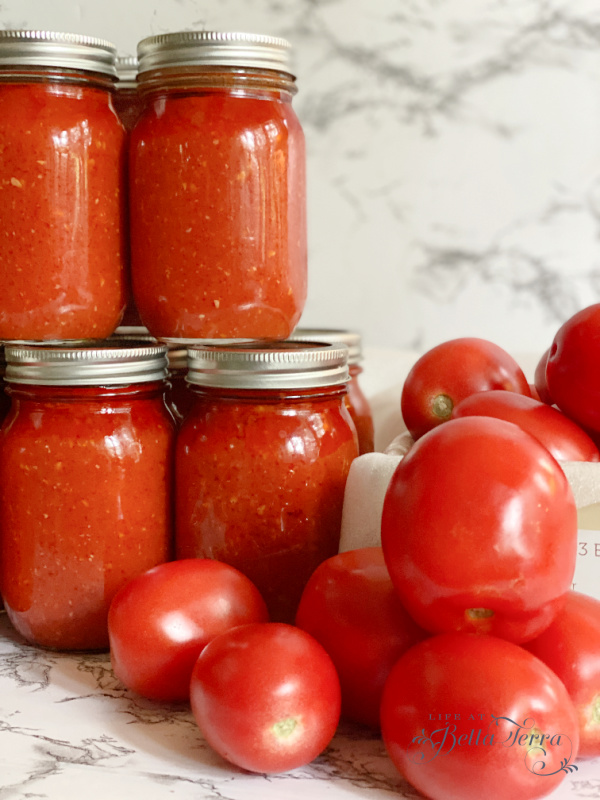
Please don’t think you need to know how to can or preserve to make this recipe. It certainly depends on the quantity of sauce you make, but you can certainly just refrigerate it if you are consuming it quickly, or freeze it.
My friend, Rick, who is a very good cook is responsible for this recipe. Like most recipes, I am always looking for a short-cut or a different way to tweak it to make it my own. Always start with good quality ingredients. Personally, I prefer to make sauce from my own tomatoes, but my crop this year wasn’t a good one. So it is time to find an alternative.
Where to Find Good Tomatoes

McClendon’s Select is family-run, certified organic farm located on 25 acres in Peoria, Arizona and an additional 68-acres in Goodyear, Arizona. How does one get 60 pounds of Roma tomatoes? Since this farm is always at our local farmers markets, you can order produce directly from them. All it took was an email asking the question. Since they do sell to restaurants, I am able to buy 20 lb. flats of tomatoes at $20.00 per flat. And as they do sell custom boxes of produce each week, I went to their drive through location and picked up the merchandise.
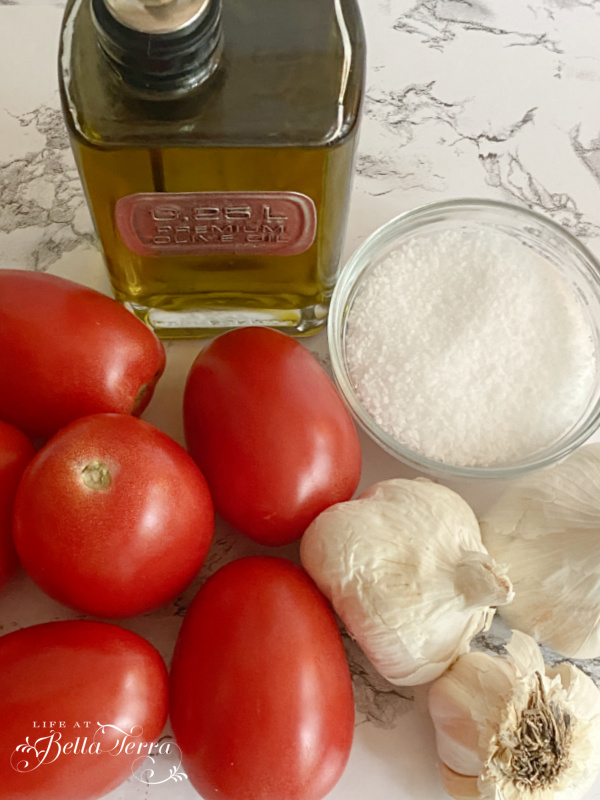
Here are the four ingredients: olive oil, garlic, Roma or plum tomatoes and salt. Making the sauce does involve cutting the tomatoes.
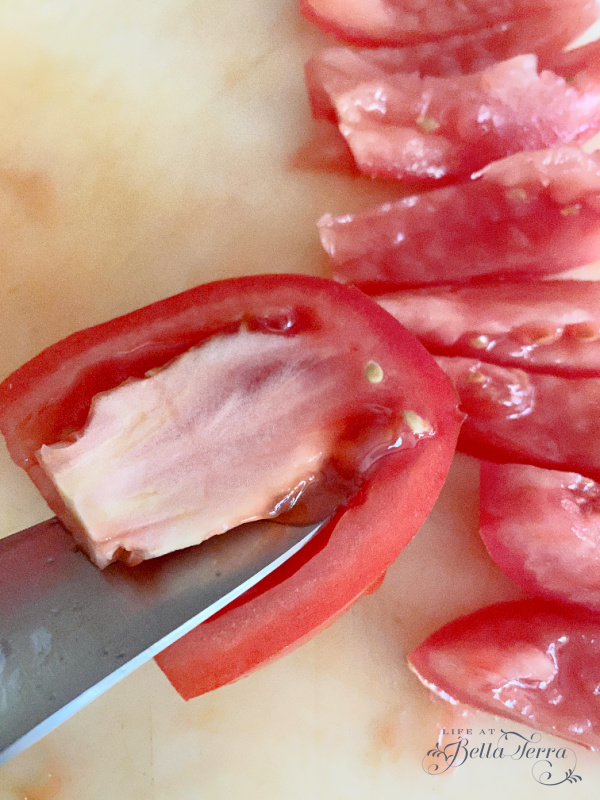
In Rick’s recipe, he suggests cutting the tomato in half, and then into a total of 16 pieces. Remove the core and seeds, saving the rest of the tomato. (Note: In order to eliminate this step, read the section on using a food mill).
Sauté the minced garlic in oil until fragrant (do not brown) and add the tomatoes and salt. Bring to a boil. Reduce heat and simmer vigorously, stirring frequently, until sauce has thickened slightly and tomato skins are starting to separate from the flesh, 15 to 20 minutes.
Other processing options
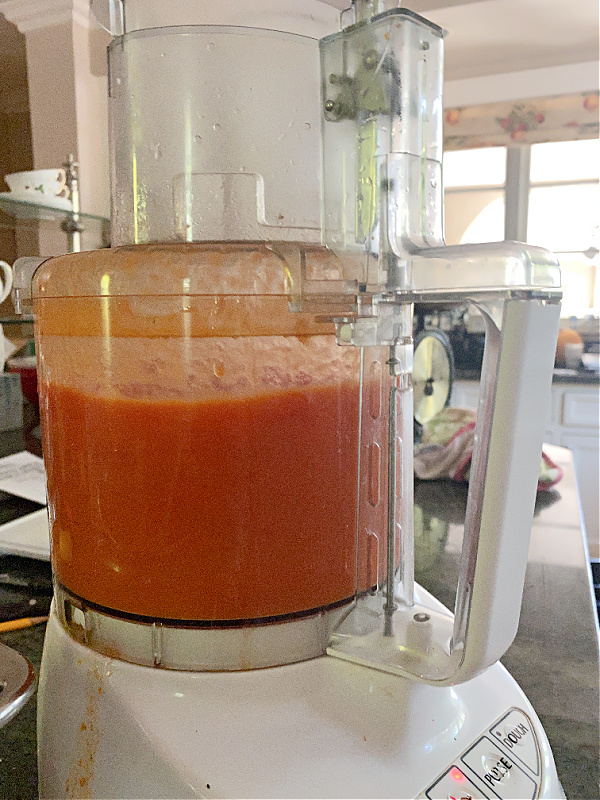
Rick’s recipe suggests using a food mill. Not everyone has a food mill and if you do not, here is an option. After cooking the tomatoes, put everything in a food processor. My Cuisinart pulvarizes the tomatoes, skins and all. The first time I made this recipe I did not own a food mill and I actually like the sauce with tiny bits of skin.
Using a Food Mill
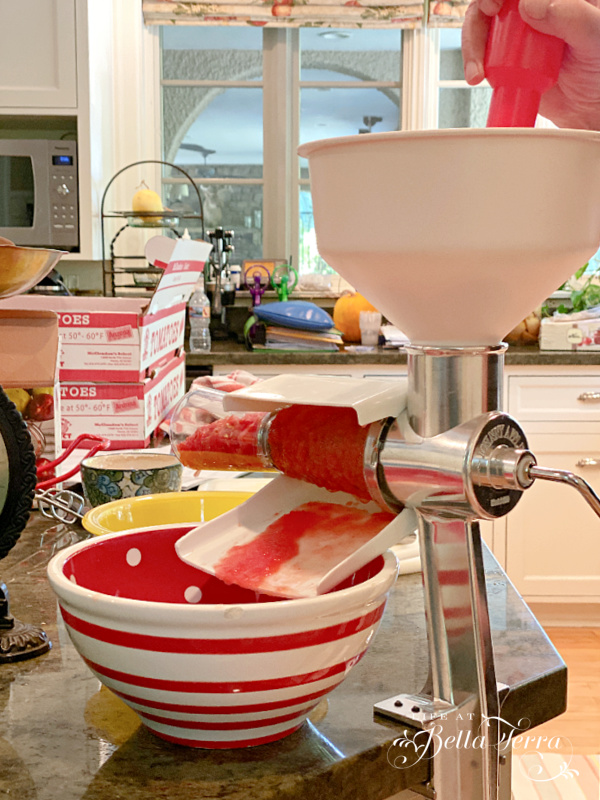
My friend, Gwen shares her favorite food mill by Roots & Branches. This large funnel sauce maker really reduces the time on making 60 lbs. of sauce. All you need to do is cut the tomatoes into a size that will fit down the throat of the funnel. Turn the hand crank and the seeds, core and skin are removed. No need to cut the tomatoes into 16 pieces. See food mill here.

What’s left is tomato pureé which you will reduce in half for a thicker sauce. Note: In Rick’s recipe, he recommends using a food mill after cooking the tomatoes the first time. The food mill I own suggests using the food mill before cooking. I have done this both ways. If your tomatoes are not soft and ripe, then I suggest using the food mill after cooking the tomatoes. Trying to put very firm, not ripe tomatoes through a food mill is difficult and can clog.
What is interesting is that regardless of when you use the food mill, the sauce is equally delicious. Note: Using such large quantities of tomatoes, I prefer not having to remove the core, skins and seeds and cutting the tomatoes into 16 pieces when the food mill does all that work for me. A real time saver.
Quantity
The recipe below, using 3 lbs. of tomatoes, produces approximately 2 cups of sauce. After using the food mill, you will get 4 cups of pureé. With a vigorous simmer, you will reduce it by half.
Preserving and Storing
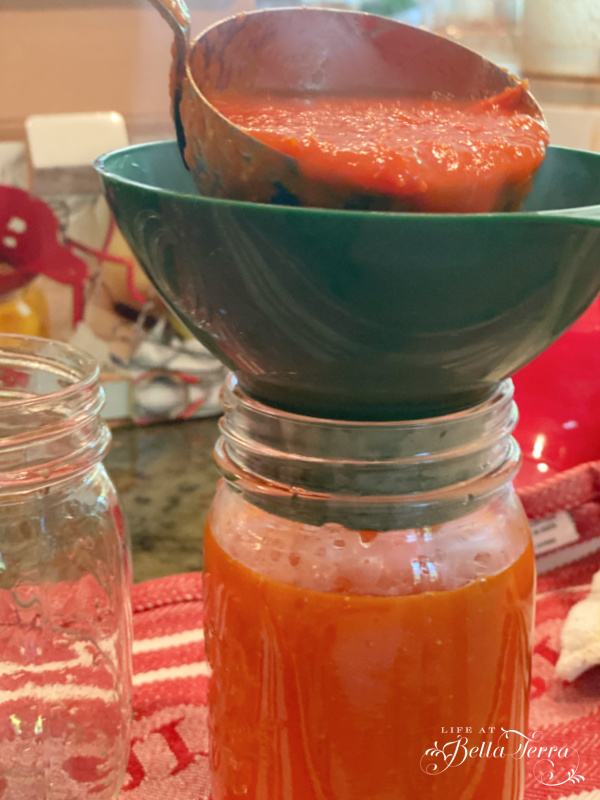
Again, depending on the quantity of tomatoes, you can either refrigerate, freeze in Ziploc bags or preserve your sauce in jars for long term storage.
To learn more about canning your sauce for year round use, see my post on Processing Tomatoes here.
Other Recipe Adjustments
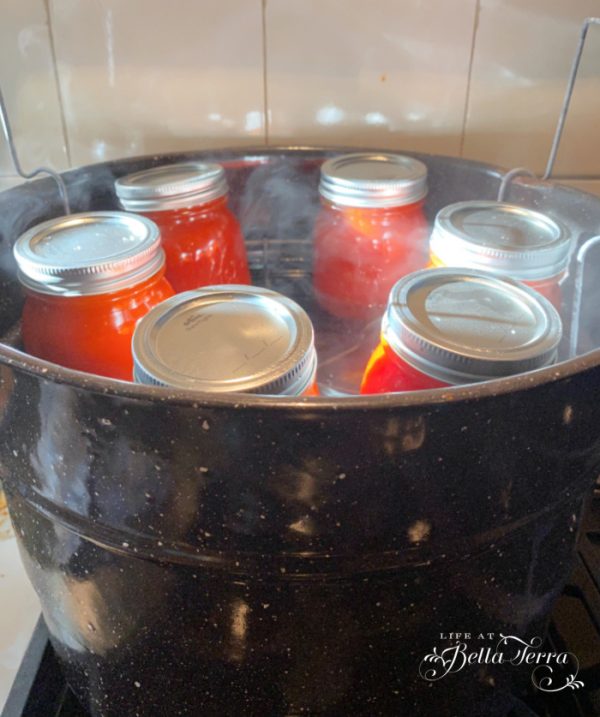
Another change I did make to Rick’s recipe is allowing the sauce to sit overnight. I did not do that, nor did I skim the floating olive oil off the sauce. I went straight to preserving and using a water bath to can the 20 jars.
My recommendation would be to follow Rick’s recipe the first time and then make any adjustments based on the quantity of your tomatoes. Needless to say, I do love this recipe because it focuses on the simple, fresh ingredients and makes a fabulous tomato sauce.
All Parts of the Tomato Used

The discarded parts of the tomato are put to good use. Happily, the chickens did receive a large tray of scraps, which they quickly consumed.
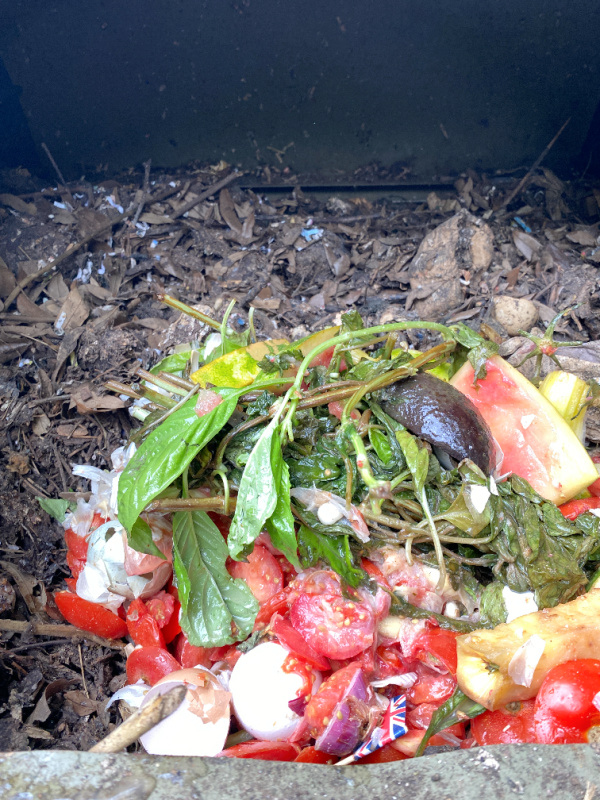
The rest of the tomato scraps are sent to the compost tumbler where their water content will help the dry yard material convert to gorgeous soil.
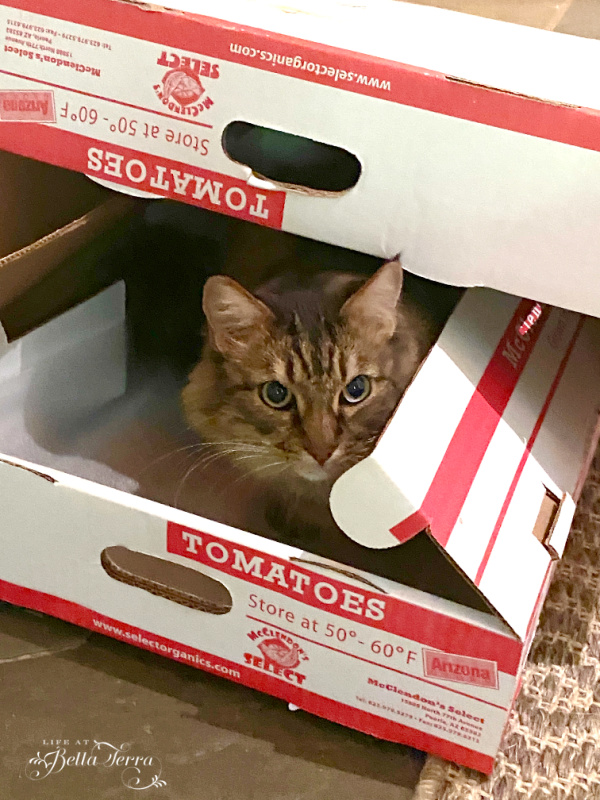
Even the tomato boxes are put into good use…..a place for Donovan, our Maine coon cat, to play.
All in all, the entire cutting, cooking, reducing and canning 60 lbs. of tomatoes did consume a weekend. But in the middle of winter when I can open a jar of fresh tomato sauce, it will be all worth it.
Happy Tuesday! As I write this it is dark and gloomy and we are praying for more rain. Have a lovely day.

If you enjoy this post, please share on Pinterest.
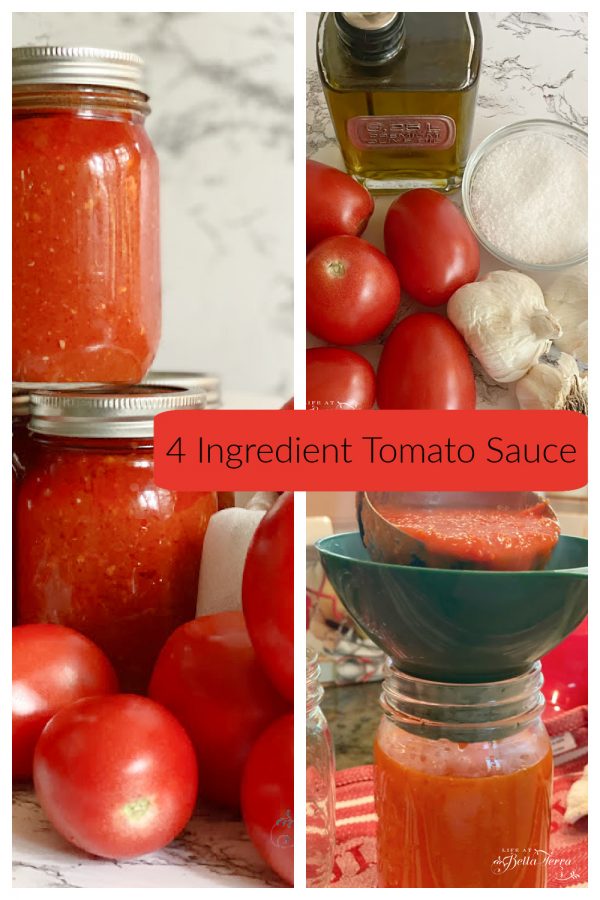
Rick’s Tomato Sauce
Ingredients
Method
- Heat oil in a large pot over medium-high heat. Add garlic and cook 20 seconds until fragrant (do not brown). Stir in tomatoes and salt. Raise heat and bring to boil. Reduce heat and simmer vigorously, stirring frequently, until sauce has thickened slightly and tomato skins are starting to separate from flesh, 15 to 20 minutes.
- Pass sauce through the medium disc of a food mill. Discard skin and seeds. Return the milled sauce to the pot. Bring to a vigorous simmer and reduce by half for a thick sauce.
- Let sauce sit (overnight in refrigerator is best). Bring to room temperature and skim off any floating olive oil (the tomato oil is great for other uses).
- Season with additional salt to taste. The sauce is ready to serve and can bee seasoned with oregano, red pepper flakes or basil.Recipe can easily be multiplied given the amount of tomatoes available and the size of the pot.Sauce freezes well and is suitable for wet bath canning.
Notes
Just a reminder that any words that are italicized bring you to the source. If it is a product on Amazon, please note that I am an Amazon Affiliate. If you purchase something through my website, I receive a small (very small!) stipend, which doesn’t affect the price you pay at all. My goal is to make sourcing the items easy for you. Thank you for your continued support.







I’m so excited to try this, Mary! It looks amazing.
Kim, it’s so delicious! Let me know if you try it with your tomatoes.
Great basic tomato sauce. Better to can it that way, then you can use it later for any kind of dish, seasoning it as desired. This is very similar to the sauce I canned. I never used a food mill, but I had a large sieve that worked perfectly to retain the seeds and skins while the gel from the seed sacks and tomato flesh would press right through. The only things I added to my recipe were lemon juice and tomato paste.. it canned beautifully.
I did want to mention that modern tomatoes have become so low in acid that the USDA states tomato products must be pressure canned for safety. As they are now classified as low acid fruits. (Tomatoes are not true vegetables),, they are actually fruits..
Definitely Sounds just like I make it ! It for sure is Exellent Tasting. Thank You for Posting it.
I bet the sauce will be amazing! This ones on my go fo list!
Yum, this sounds delicious Mary, and I can’t wait to try it. I once talked to a young exchange student from Italy and he said all you need is the right kind of tomatoes and olive oil to make a good sauce 🙂
Great post, Mary!
If you love the tomatoes you are using for your sauce, you can save some of the seeds, dry them, and use them to grow plants for next year.
To collect and save the seeds, I use paper towels to wipe seeds off the cutting board, let the paper towels dry, then separate them (with seeds embedded) into a single ply. Then I tear the paper towel into little bits with just a seed or two on every piece. When it’s time to plant, I bury the piece of paper towel with the seed(s). In the ground, the paper absorbs water to keep the seed moist and then decomposes, adding organic matter to the soil. It works great!
You and Rick!!! We have ball jars all over the kitchen!!! It is soooo good..
How wonderful to have fresh sauce in the winter!
I’m curious, how many jars were made from 60 pounds of tomatoes.
Karen, We ended up with 20 16 oz. jars…..after my husband said, “lots of work for not much sauce”….But I am thrilled as it tastes so good and when we eat heartier dishes in the winter I will appreciate having it.
What a great post. An amazing amount of work !!!
Alan, Thank you !
You are amazing! I don’t know how you do it all. Hugs to you.
What is the reason one doesn’t use the whole tomato, seeds and all?
Eileen, that is a great question. First of all, generally the seeds and gel contribute to the watery consistency of the pureé. My guess is that it would take much longer to reduce it in half. Secondly, aesthetically, some people don’t like seeds. And lastly, I did read that seeds can contribute to the bitterness of the sauce. Having said that, naturally some seeds make it into the sauce and in the recipe where I do not use a food mill, I put the skins (minus the gelatinous seeds) into the sauce. Even with some good pulverizing, there are still segments of skin. I suppose at the end of the day it’s a matter of personal preference. Thanks for asking.